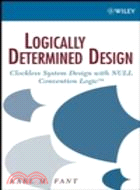| FindBook |
有 1 項符合
LOGICALLY DETERMINED DESIGN的圖書 |
 |
LOGICALLY DETERMINED DESIGN 作者:FANT 出版社:JOHN WILEY & SONS 出版日期:2005-01-01 |
| 圖書館借閱 |
| 國家圖書館 | 全國圖書書目資訊網 | 國立公共資訊圖書館 | 電子書服務平台 | MetaCat 跨館整合查詢 |
| 臺北市立圖書館 | 新北市立圖書館 | 基隆市公共圖書館 | 桃園市立圖書館 | 新竹縣公共圖書館 |
| 苗栗縣立圖書館 | 臺中市立圖書館 | 彰化縣公共圖書館 | 南投縣文化局 | 雲林縣公共圖書館 |
| 嘉義縣圖書館 | 臺南市立圖書館 | 高雄市立圖書館 | 屏東縣公共圖書館 | 宜蘭縣公共圖書館 |
| 花蓮縣文化局 | 臺東縣文化處 |
|
|
- 圖書簡介
This seminal book presents a new logically determined design methodology for designing clockless circuit systems. The book presents the foundations, architectures and methodologies to implement such systems. Based on logical relationships, it concentrates on digital circuit system complexity and productivity to allow for more reliable, faster and cheaper products.
* Transcends shortcomings of Boolean logic.
* Presents theoritical foundations, architecture and analysis of clockless (asynchronous) circuit design.
* Contains examples and exercises making it ideal for those studying the area. - 作者簡介
KARL M. FANT is President of Theseus Research, Inc. After serving as a Research Fellow at Honeywell, he co-founded Theseus Research and then Theseus Logic, which is now commercializing NULL Convention LogicTM. He holds twenty-nine patents and has published numerous papers.
- 目次
Preface.
Acknowledgments.
1. Trusting Logic.
1.1 Mathematicianless Enlivenment of Logic Expression.
1.2 Emulating the Mathematician.
1.3 Supplementing the Expressivity of Boolean Logic.
1.4 Defining a Sufficiently Expressive Logic.
1.5 The Logically Determined System.
1.6 Trusting the Logic: A Methodology of Logical Confidence.
1.7 Summary.
1.8 Exercises.
2. A Sufficiently Expressive Logic.
2.1 Searching for a New Logic.
2.2 Deriving a 3 Value Logic.
2.3 Deriving a 2 Value Logic.
2.4 Compromising Logical Completeness.
2.5 Summary.
3. The Structure of Logically Determined Systems.
3.1 The Cycle.
3.2 Basic Pipeline Structures.
3.3 Control Variables and Wavefront Steering.
3.4 The Logically Determined System.
3.5 Initialization.
3.6 Testing.
3.7 Summary.
3.8 Exercises.
4. 2NCL Combinational Expression.
4.1 Function Classification.
4.2 The Library of 2NCL Operators.
4.3 2NCL Combinational Expression.
4.4 Example 1: Binary Plus Trinary to Quaternary Adder.
4.5 Example 2: Logic Unit.
4.6 Example 3: Minterm Construction.
4.7 Example 4: A Binary Clipper.
4.8 Example 5: A Code Detector.
4.9 Completeness Sufficiency.
4.10 Greater Combinational Composition.
4.11 Directly Mapping Boolean Combinational Expressions.
4.12 Summary.
4.13 Exercises.
5. Cycle Granularity.
5.1 Partitioning Combinational Expressions.
5.2 Partitioning the Data Path.
5.3 Two-dimensional Pipelining: Orthogonal Pipelining Across a Data Path.
5.4 2D Wavefront Behavior.
5.5 2D Pipelined Operations.
5.6 Summary.
5.7 Exercises.
6. Memory Elements.
6.1 The Ring Register.
6.2 Complex Function Registers.
6.3 The Consume/Produce Register Structure.
6.4 The Register File.
6.5 Delay Pipeline Memory.
6.6 Delay Tower.
6.7 FIFO Tower.
6.8 Stack Tower.
6.9 Wrapper for Standard Memory Modules.
6.10 Exercises.
7. State Machines.
7.1 Basic State Machine Structure.
7.2 Exercises.
8. Busses and Networks.
8.1 The Bus.
8.2 A Fan-out Steering Tree.
8.3 Fan-in Steering Trees Do Not Work.
8.4 Arbitrated Steering Structures.
8.5 Concurrent Crossbar Network.
8.6 Exercises.
9. Multi-value Numeric Design.
9.1 Numeric Representation.
9.2 A Quaternary ALU.
9.3 A Binary ALU.
9.4 Comparison.
9.5 Summary.
9.6 Exercises.
10. The Shadow Model of Pipeline Behavior.
10.1 Pipeline Structure.
10.2 The Pipeline Simulation Model.
10.3 Delays Affecting Throughput.
10.4 The Shadow Model.
10.5 The Value of the Shadow Model.
10.6 Exercises.
11. Pipeline Buffering.
11.1 Enhancing Throughput.
11.2 Buffering for Constant Rate Throughput.
11.3 Summary of Buffering.
11.4 Exercises.
12. Ring Behavior.
12.1 The Pipeline Ring.
12.2 Wavefront-limited Ring Behavior.
12.3 The Cycle-to-Wavefront Ratio.
12.4 Ring Signal Behavior.
13. Interacting Pipeline Structures.
13.1 Preliminaries.
13.2 Example 1: The Basics of a Two-pipeline Structure.
13.3 Example 2: A Wavefront Delay Structure.
13.4 Example 3: Reducing the Period of the Slowest Cycle.
13.5 Exercises.
14. Complex Pipeline Structures.
14.1 Linear Feedback Shift Register Example.
14.2 Grafting Pipelines.
14.3 The LFSR with a Slow Cycle.
14.4 Summary.
14.5 Exercises.
Appendix A: Logically Determined Wavefront Flow.
A.1 Synchronization.
A.2 Wavefronts and Bubbles.
A.3 Wavefront Propagation.
A.4 Extended Simulation of Wavefront Flow.
A.5 Wavefront and Bubble Behavior in a System.
Appendix B: Playing with 2NCL.
B.1 The SR Flip-flop Implementations.
B.2 Initialization.
B.3 Auto-produce and Auto-consume.
Appendix C: Pipeline Simulation.
References.
Index.
|











